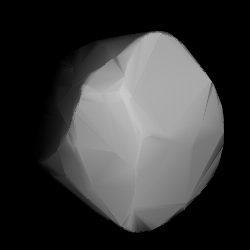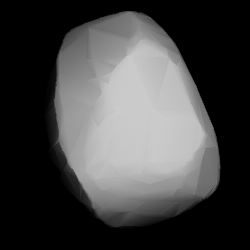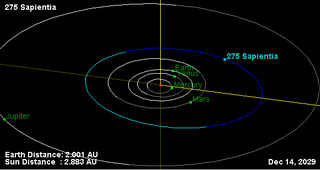
56 Melete is a large and dark main belt asteroid. It is a rather unusual P-type asteroid, probably composed of organic rich silicates, carbon and anhydrous silicates, with possible internal water ice. The asteroid orbits the Sun with a period of 4.18 years.

92 Undina is a large main belt asteroid. The asteroid was discovered by Christian Peters on 7 July 1867 from the Hamilton College Observatory. It is named for the eponymous heroine of Undine, a popular novella by Friedrich de la Motte Fouqué.

154 Bertha is a main-belt asteroid. It was discovered by the French brothers Paul Henry and Prosper Henry on 4 November 1875, but the credit for the discovery was given to Prosper. It is probably named after Berthe Martin-Flammarion, sister of the astronomer Camille Flammarion.

164 Eva is a main-belt asteroid that was discovered by the French brothers Paul Henry and Prosper Henry on July 12, 1876, in Paris. The reason the name Eva was chosen remains unknown, though Karl Ludwig Littrow suspected a "worldly origin". The orbital elements for 164 Eva were published in 1877 by American astronomer Winslow Upton. It is categorized as a C-type asteroid and is probably composed of primitive carbonaceous chondritic materials.

191 Kolga is a large, dark main-belt asteroid that was discovered by German-American astronomer C. H. F. Peters on September 30, 1878, in Clinton, New York. It is named after Kólga, the daughter of Ægir in Norse mythology.

209 Dido is a main-belt asteroid with a diameter of 179±1 km. It was discovered by C. H. F. Peters on October 22, 1879, in Clinton, New York and was named after the mythical Carthaginian queen Dido. This asteroid is orbiting the Sun at a distance of 3.15 AU with an eccentricity (ovalness) of 0.058 and a period of 5.59 yr. The orbital plane is tilted at an angle of 7.2° to the plane of the ecliptic.

275 Sapientia is a very large Main belt asteroid that was discovered by Johann Palisa on 15 April 1888 in Vienna. It is classified as a C-type asteroid and is probably composed of carbonaceous material. It is named for the Roman personification of wisdom, Sapientia.

365 Corduba is a very large main-belt asteroid that was discovered by the French astronomer Auguste Charlois on 21 March 1893 from Nice. It is classified as a C-type asteroid and is probably composed of carbonaceous material.

402 Chloë is a large main-belt asteroid. It was discovered by French astronomer Auguste Charlois on 21 March 1895 from Nice. This asteroid is orbiting the Sun at a distance of 2.56 AU with a period of 4.09 years and an eccentricity of 0.11. The orbital plane is inclined at an angle of 11.8° to the plane of the ecliptic.

409 Aspasia is a large main-belt asteroid that was discovered by French astronomer Auguste Charlois on 9 December 1895 in Nice. It is classified as a CX-type asteroid.
469 Argentina is an asteroid that was discovered by Luigi Carnera on 20 February 1901. Its provisional name was 1901 GE. 469 Argentina has an estimated rotation period of 12.3 hours.
554 Peraga is a minor planet orbiting the Sun that was discovered by German astronomer Paul Götz on January 8, 1905, from Heidelberg.
568 Cheruskia is a minor planet, specifically an asteroid orbiting in the asteroid belt that was discovered by German astronomer Paul Götz on 26 July 1905 from Heidelberg.
585 Bilkis is a minor planet, specifically an asteroid orbiting in the asteroid belt. It was discovered by German astronomer August Kopff in 1906 February and was given the Koran name for the Queen of Sheba. Photometric observations at the Palmer Divide Observatory in Colorado Springs, Colorado in 2006–7 were used to build a light curve for this object. The asteroid displayed a rotation period of 8.5742 ± 0.0005 hours and a brightness variation of 0.40 ± 0.02 in magnitude.
687 Tinette is a minor planet, specifically an asteroid orbiting primarily in the asteroid belt. It was discovered by Austrian astronomer Johann Palisa on 16 August 1909 from Vienna and was given the preliminary designation 1909 HG.

747 Winchester is an asteroid, a minor planet orbiting the Sun. It was discovered in 1913, and is named after the town in which it was discovered, Winchester, Massachusetts, in the USA.
756 Lilliana is a minor planet orbiting the Sun that was discovered by American astronomer Joel Hastings Metcalf on 26 April 1908 from Taunton, Massachusetts. It rotates around its axis of rotation every 9.36 hours.
947 Monterosa is a minor planet orbiting the Sun.
1817 Katanga, provisional designation 1939 MB, is a stony Phocaea asteroid in from the inner regions of the asteroid belt, approximately 16 kilometers in diameter. It was discovered on 20 June 1939, by English-born South African astronomer Cyril Jackson at Johannesburg Observatory in South Africa. It is named for the Katanga Province.
1951 Lick, provisional designation 1949 OA, is a rare-type asteroid and Mars-crosser, approximately 5.6 kilometers in diameter. It was discovered on 26 July 1949, by American astronomer Carl Wirtanen at Lick Observatory on the summit of Mount Hamilton, California, and named for American philanthropist James Lick.











